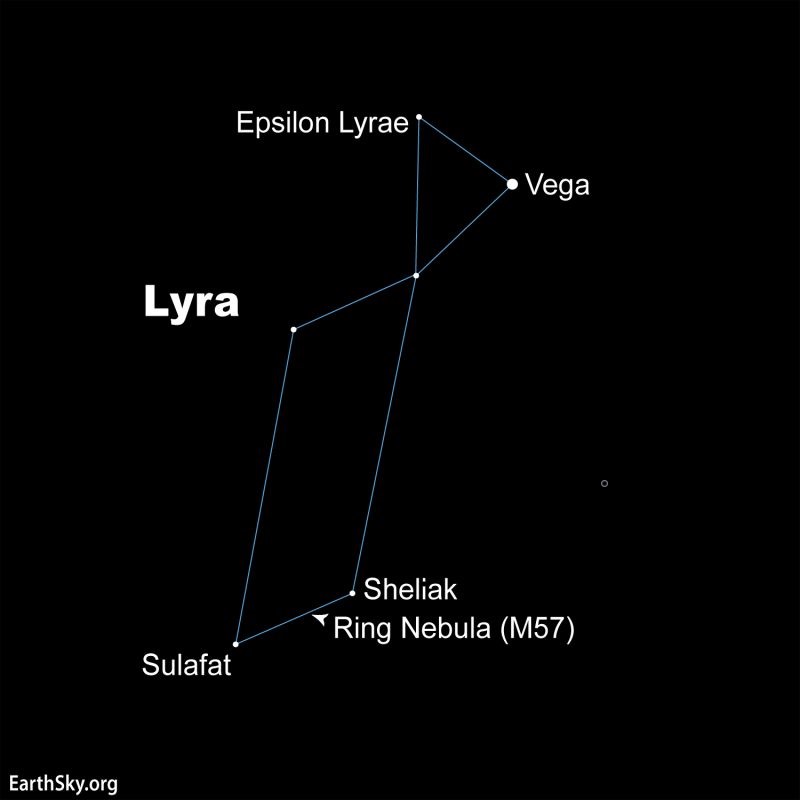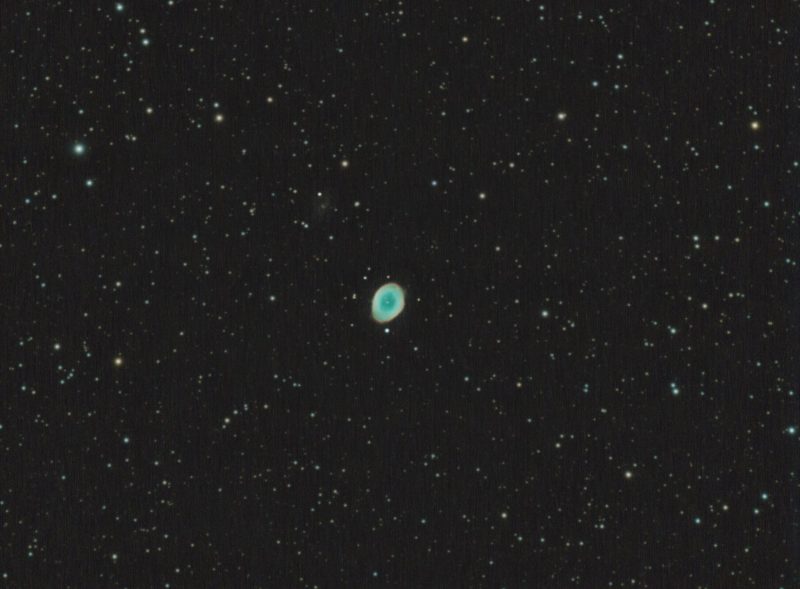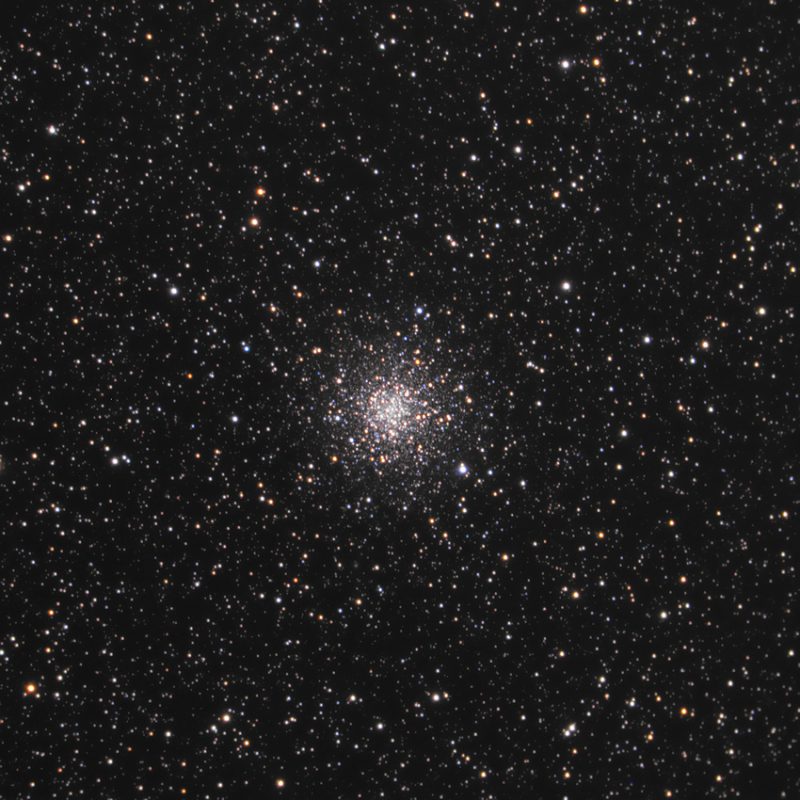
Yes, Lyra is a small constellation, 52nd out of the 88 constellations. But it has a big presence. That’s because its bright star Vega is prominent in northern summer skies and it’s a corner of the famous Summer Triangle star pattern. Vega shines at magnitude 0.03, which makes it the 5th brightest star in Earth’s sky, or the 2nd brightest star belonging to just the Northern Hemisphere. Vega is so bright because it lies just 25 light-years away.
Lyra is described as a harp, lyre or stringed instrument. And it’s one of the constellations that Ptolemy named back in the 2nd century.
How to find Lyra
The easiest way to find Lyra is to look directly overhead on summer evenings in the Northern Hemisphere. The brightest star closest to the zenith on a summer night after the sky gets dark is Vega. It will get closer to the zenith and pass through it as the evening turns to morning.
Once you find Vega, wait until your eyes are dark adjusted so that you can make out the parallelogram dangling below it. Then, when you look back toward Vega, can you trace out a small triangle shape attached to the parallelogram? That star in the small triangle and which is not part of the parallelogram – or Vega – is Epsilon Lyrae, and we’ll get to it later.

A hotbed of double stars
Now that we’ve met Vega (Alpha Lyrae), let’s meet the other stars in the Harp. The two stars in the parallelogram closest to Vega are the dimmer of the four stars. These two stars are both double stars. The double star directly below Vega is Zeta Lyrae. The stars in this pair have magnitudes 4.34 and 5.73. They lie just 44 arcseconds from each other and 150 light-years away from us. Of course, a telescope can easily split the pair, but a good pair of binoculars may work as well.
The next double star in the parallelogram consists of Delta 1 and 2 Lyrae. The brighter star has magnitude 4.22, and the dimmer is of magnitude 5.58. They lie 10 arcminutes from each other, so you can easily split them in binoculars. The Delta 1 and 2 stars lie 1,080 and 898 light-years away, respectively.
Finally, the last double hovering around Vega is Epsilon Lyrae, which completes the small triangle near Vega. Epsilon Lyra is more famously known as the Double Double. A telescope reveals that this double star is actually a quadruple system. Epsilon 1 lies 3 1/2 arcminutes from Epsilon 2. The Epsilon 1 stars have magnitudes 4.7 and 6.2, and the Epsilon 2 stars have magnitudes 5.1 and 5.5. This multiple star system lies about 160 light-years away.

The rest of the stars of the Harp
Next, continuing on down to the bottom of the parallelogram, we find the stars Beta Lyrae, or Sheliak, and Sulafat, or Gamma Lyrae. Sulafat is the star farthest from Vega. It shines at magnitude 3.25 at a distance of 635 light-years. Sheliak is the last star in the parallelogram and – surprise! – it is also a double star. The main star has a magnitude of 3.52 and its companion is of magnitude 7.14. You can split this eclipsing binary in large telescopes.

Deep-sky objects in Lyra
Two Messier objects reside in Lyra. First, is a planetary nebula, M57, also known as the Ring Nebula. Without a doubt, it’s one of the most observed objects of its type in the sky. It shines at magnitude 9.0 from about 2,300 light-years away. Luckily, it’s easy to find by looking between the bottom two stars of the parallelogram, Sheliak and Sulafat. Use a telescope to catch its oval glow.

Then a little more than halfway from Sulafat, the bottom star in the parallelogram, and Albireo, the bright double star at the end of Cygnus, you’ll find M56, a loose globular cluster. M56 is a magnitude 8.3 grouping orbiting the Milky Way, lying almost 33,000 light-years away.

Bottom line: Lyra the Harp is a constellation that hosts the second brightest star in the northern sky, Vega. Look for it on summer nights.
The post Lyra the Harp contains Vega, a summer gem first appeared on EarthSky.
from EarthSky https://ift.tt/pGHIvCm

Yes, Lyra is a small constellation, 52nd out of the 88 constellations. But it has a big presence. That’s because its bright star Vega is prominent in northern summer skies and it’s a corner of the famous Summer Triangle star pattern. Vega shines at magnitude 0.03, which makes it the 5th brightest star in Earth’s sky, or the 2nd brightest star belonging to just the Northern Hemisphere. Vega is so bright because it lies just 25 light-years away.
Lyra is described as a harp, lyre or stringed instrument. And it’s one of the constellations that Ptolemy named back in the 2nd century.
How to find Lyra
The easiest way to find Lyra is to look directly overhead on summer evenings in the Northern Hemisphere. The brightest star closest to the zenith on a summer night after the sky gets dark is Vega. It will get closer to the zenith and pass through it as the evening turns to morning.
Once you find Vega, wait until your eyes are dark adjusted so that you can make out the parallelogram dangling below it. Then, when you look back toward Vega, can you trace out a small triangle shape attached to the parallelogram? That star in the small triangle and which is not part of the parallelogram – or Vega – is Epsilon Lyrae, and we’ll get to it later.

A hotbed of double stars
Now that we’ve met Vega (Alpha Lyrae), let’s meet the other stars in the Harp. The two stars in the parallelogram closest to Vega are the dimmer of the four stars. These two stars are both double stars. The double star directly below Vega is Zeta Lyrae. The stars in this pair have magnitudes 4.34 and 5.73. They lie just 44 arcseconds from each other and 150 light-years away from us. Of course, a telescope can easily split the pair, but a good pair of binoculars may work as well.
The next double star in the parallelogram consists of Delta 1 and 2 Lyrae. The brighter star has magnitude 4.22, and the dimmer is of magnitude 5.58. They lie 10 arcminutes from each other, so you can easily split them in binoculars. The Delta 1 and 2 stars lie 1,080 and 898 light-years away, respectively.
Finally, the last double hovering around Vega is Epsilon Lyrae, which completes the small triangle near Vega. Epsilon Lyra is more famously known as the Double Double. A telescope reveals that this double star is actually a quadruple system. Epsilon 1 lies 3 1/2 arcminutes from Epsilon 2. The Epsilon 1 stars have magnitudes 4.7 and 6.2, and the Epsilon 2 stars have magnitudes 5.1 and 5.5. This multiple star system lies about 160 light-years away.

The rest of the stars of the Harp
Next, continuing on down to the bottom of the parallelogram, we find the stars Beta Lyrae, or Sheliak, and Sulafat, or Gamma Lyrae. Sulafat is the star farthest from Vega. It shines at magnitude 3.25 at a distance of 635 light-years. Sheliak is the last star in the parallelogram and – surprise! – it is also a double star. The main star has a magnitude of 3.52 and its companion is of magnitude 7.14. You can split this eclipsing binary in large telescopes.

Deep-sky objects in Lyra
Two Messier objects reside in Lyra. First, is a planetary nebula, M57, also known as the Ring Nebula. Without a doubt, it’s one of the most observed objects of its type in the sky. It shines at magnitude 9.0 from about 2,300 light-years away. Luckily, it’s easy to find by looking between the bottom two stars of the parallelogram, Sheliak and Sulafat. Use a telescope to catch its oval glow.

Then a little more than halfway from Sulafat, the bottom star in the parallelogram, and Albireo, the bright double star at the end of Cygnus, you’ll find M56, a loose globular cluster. M56 is a magnitude 8.3 grouping orbiting the Milky Way, lying almost 33,000 light-years away.

Bottom line: Lyra the Harp is a constellation that hosts the second brightest star in the northern sky, Vega. Look for it on summer nights.
The post Lyra the Harp contains Vega, a summer gem first appeared on EarthSky.
from EarthSky https://ift.tt/pGHIvCm

Aucun commentaire:
Enregistrer un commentaire